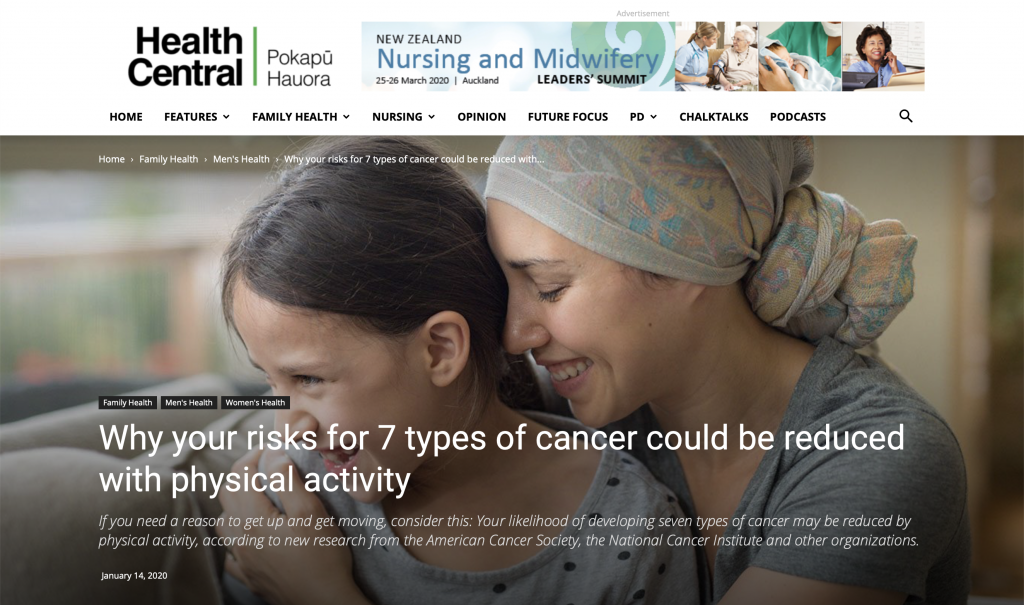Thoughts on a recent Journal of Clinical Oncology paper: Amount and Intensity of Leisure-Time Physical Activity and Lower Cancer Risk (December 26th, 2019).
On 16/01/2020 Physiotherapy New Zealand shared an article from Healthcentral.nz which appears to have been written by the New Zealand Herald – image of the article header below:
The article was also reported on by The Washington Post on 13-01-2020 .
So…. What’s the beef? This all sounds great right?
As a very strong advocate for “Exercise For Life”, you might be wondering why I am doing a review on something that sounds “right up my alley”. Well, it is important that we have a look at and discuss the good as well as bad information that is out there and try to explain what this actually means for you (and/or your clients/patients).
For anyone who would like to read a copy of the full text article, it is available at this link (not even behind a paywall) – the Data supplement is available here.
So, to get started, we will start at the top – the numbers.
- 1.7 million Americans will be diagnosed with cancer each year – that’s out of a population of of 330 million.
- This is a rate of 515 people per 100000pop. for all cancers (as a basic calculation – not ASIR) but the official age-standardized incidence rate (ASIR) for 2018 is noted on the World Cancer Research Fund page as 352.2 per 100000pop.
- New Zealand (where I live) has an ASIR of 438.1 per 100000pop.
- Australia sits at an ASIR of 468.0 per 100000pop. – the highest in the world.
- Europe has rates as high as 373.7 (Ireland) and as low as 242.8 (Lebanon).
Why is this important to discuss? Well, the study used 9 cohorts (large groups of people), 5 from America, 3 from Europe and 1 from Australia, all between the ages of 32 and 91, so you would expect that the cancer rate should sit somewhere between the worst 468.0 and the best 242.8 of the possible cohort participants.
In the study, they only looked at 15 different types of cancer that were associated or may be associated with activity, not all cancer types. They reported 50,620 cancer diagnoses (of the 15 types assessed) in a group of 755,459. That is a per 100000pop. rate of 670. That works out to be a 43% higher incidence rate than the highest ASIR in the world – and while you can say “this is not an ASIR”, you would be right and the process of standardising the data is statistically powerful and would no doubt alter the rate, but, it is also important to note that this rate was only taking into account the cancer diagnoses that the study was looking at. My main concern here was that there was little discussion of the apparently high incidence rate within the cohort groups and what this meant for the outcomes of the study.
The outcome
The point of the study was to look at activity involvement and intensity and see the effect that this has on cancer risk. This is where the good news is – for a large portion of the cancers included, there was a statistically supported decrease in risk with activity that met the recommended physical activity guidelines (2.5-5hours per week of moderate activity). Here is where I put the note that “statistically supported” simply means that the activity resulted in a decreased risk, not that the decrease was a large/worthwhile amount – more on that later (under “Results”).
With the popularity of HIIT training these days, it simply wouldn’t do to miss an opportunity to comment on higher intensity exercise. So, for those that were involved in higher intensity activity that was associated with a further reduction in risk for breast, colon, endometrial, head & neck and esophageal adenocarcinoma. So yes, it does look like higher intensity training can be useful in this sphere of health too! Although, the relationship was not linear for all cancers, so, if you are aiming for reduction of risk across “the spread”, its not a case of “Higher intensity = lower risk”.
The reality here is that as long as the activity was at least moderate in intensity and for the recommended 2.5-5 hours per week, the study did not find any differences in the type of exercise – so do something that you like/love.
Some of the weaknesses in this study are: the groups were predominantly white (95%) in race and had 53% female (the world is closer to 30% white & 50-50 male-female) and the assessment was a self-report questionnaire (considering the preceding 3 month/12 month period) which I could not, for the life of me, find out when it was administered in the 10.1 year study period, but I assume at the beginning. Given there was no follow-up, it is not possible to know if people continued with the activity at the same levels for the entire study period, and if their levels changed, how this impacted the cancer risk.
Results:
Well here is where the good news is, there was a noted reduction in 7 out of the assessed 15 cancer types between 6% (lowest effect) and 27% (highest effect). Liver cancer had the highest response with a 27% decreased incidence with a normal ASIR of 10.1, and breast cancer was the lowest effect of a 6% decrease with a normal ASIR of 45.91 (2017 data).
So to put this in a real world scenario – while 27% reduction in risk of liver cancer is huge, with a 10.1 diagnoses per 100000 population ASIR, here in New Zealand, this would drop the diagnosis rate from 48 people per year to 35. Now this means a whole lot for the 13 people not being diagnosed in that year, but it does not stop them being given the diagnosis the following year. If you look at it from a simple risk perspective, you would drop from a 0.01% risk to a 0.01% risk (both rounded to 2 decimal places)…… damn…….
Where we look at breast cancer, a 6% reduction in the 45.91 ASIR would take it to 43.16 so a risk of 0.05% to 0.04% per year but a reduction from 2201 diagnoses to 2069 meaning 132 less diagnoses per year.
The important thing to remember here is that cancer is a VERY complex condition to do with genetic coding, cell replication, exposure to chemicals/irritant/carcinogens and other factors. So it is never going to be as simple as seeing huge reductions in risk from exercise, or even exercise and diet as a health approach.
Discussion:
So is it really an awesome study helping people avoid cancer?
- Like a lot of these cohort studies, looking at a large group of people means that the outcomes will relate to large groups too. So yes, yes it is good news for population risk.
Does it say that YOUR cancer risks will be significantly reduced by exercise of a set intensity or following baseline exercise recommendations?
- Well, probably not.
So should you go out and get cracking with that new year’s resolution to do more exercise, live a fitter and healthier life?
- Of course! Every risk factor you help to reduce is a positive, but it is a risk/reward process. The chances of a HUGE effect are minimal, but the other side effects of exercise (beyond cancer risk rates) are many and mostly positive (improved sleep, decreased pain, improved energy levels etc) so it’s a win/win.
If your goal is to reduce cancer risk, spending a fortune on “health coaches” or trainers for specific programmes will be highly unlikely to make a major difference, but in this case, getting more active (2.5-5 hours of moderate activity per week), no matter what your chosen exercise is, will likely set you in good stead (add in a diet of largely unprocessed foods with lots of fruit and vegetables and you can further “up” your efficacy!).
What can we take away?
So in conclusion, exercise is good for you, and there is real data out there that supports the use of activity in reducing your cancer risk, so get to it, get up and get moving every day, and as a community, we will all see less cancer in our midst.
If you are unsure where to get started and know that you have some risk factors, get to your GP for a review and then engage a well-qualified exercise professional to get you a self management exercise programme with some input to keep it fresh and fun for you (after all, fresh and fun is what keeps you going back to do it).
Health & Fitness
Az

The above article does not represent professional recommendations on treatment or an opinion on any person or persons medical condition(s). It is an opinion piece reviewing the linked research and should be viewed as such.
